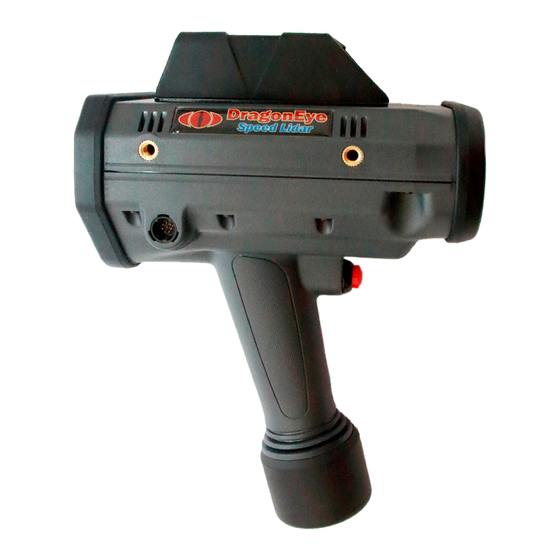Advertisement
DragonEye
®
SPEED LIDAR
Operator Manual
Canadian Version
Doc: 30508 Rev. 05
© 2013 by DragonEye Technology, LLC. All rights reserved. No part of this
document may be reproduced or transmitted in any form or by any means,
electronic, mechanical, photocopying, recording, or otherwise, without prior
written permission of DragonEye Technology, LLC.
Advertisement
Table of Contents

Subscribe to Our Youtube Channel
Summary of Contents for DragonEye SPEED LIDAR
- Page 1 Canadian Version Doc: 30508 Rev. 05 © 2013 by DragonEye Technology, LLC. All rights reserved. No part of this document may be reproduced or transmitted in any form or by any means, electronic, mechanical, photocopying, recording, or otherwise, without prior...
-
Page 2: Basic Operation
® Basic Operation The following sections give an overview of the basic operation of the DragonEye Speed LIDAR® for normal speed measurement applications. Be sure to review the “Recommended System Checks” section to understand the suggested daily performance checks and periodic certifications. - Page 3 If you haven’t used a HUD device before, it might take a minute or two for your eyes to adjust the first time. HUD Aiming Reticle (Note: Make sure the LIDAR’s brightness setting is on medium or high if working in daylight.) DragonEye Technology, LLC | Doc. 30508 Rev 05...
- Page 4 This is your aim point for target vehicles. Roadside Setup When first learning to use the DragonEye Speed LIDAR®, it is best to select a straight stretch of roadway with a line of sight of 150 metres or more. (or follow your provincial program)
- Page 5 Both the HUD and the back panel will show a “-“ sign for receding vehicles.) The DragonEye Speed LIDAR® will continuously update the target’s speed reading at an approximate rate of 3 times per second as long as the trigger is depressed and the data quality is acceptable. While not required, it is recommended to track the vehicle for at least 1 second to establish robust confidence in the speed reading.
-
Page 6: Range Mode
Range readings are displayed in tenths of a metre on the rear panel and in the HUD up to 999.9 metres. Above this, range readings are displayed to the nearest integer metre. DragonEye Technology, LLC | Doc. 30508 Rev 05... - Page 7 >610 metres to a white concrete building and 305metres from a very black, non-reflective target. The minimum range (in “Normal” Weather/Obstruction Mode) is 3 metres. DragonEye Technology, LLC | Doc. 30508 Rev 05...
- Page 8 However we recommend performing the following system checks before each shift that the operator is going to use the DragonEye Speed LIDAR ® for enforcement purposes. This will ensure operator confidence in the instrument:...
-
Page 9: Alignment Test
This will allow the operator to confirm that the infrared energy is contained within the aiming reticule and the Lidar will confirm the range selected to perform this test. The operator will again be prompted to press the button. DragonEye Technology, LLC | Doc. 30508 Rev 05... -
Page 10: Appendix A - Cosine Effect
“Line V” is projected onto the LIDAR operator’s line of sight “Line O”. Using standard trigonometry, this projected motion can be shown to ΔO = ΔV x COSΘ Line V ΔV Θ ΔO Line O DragonEye Technology, LLC | Doc. 30508 Rev 05...


Need help?
Do you have a question about the SPEED LIDAR and is the answer not in the manual?
Questions and answers